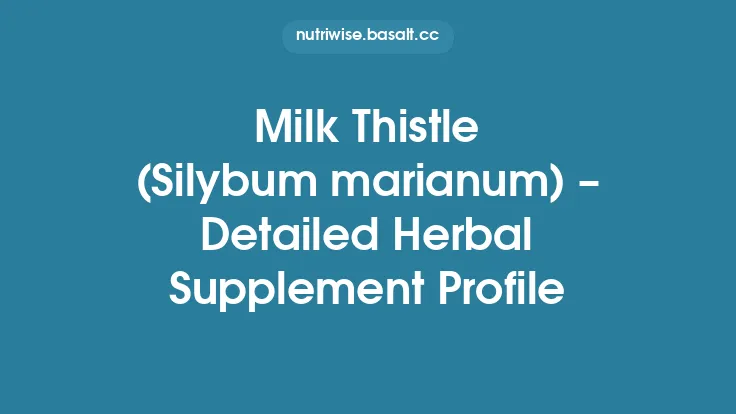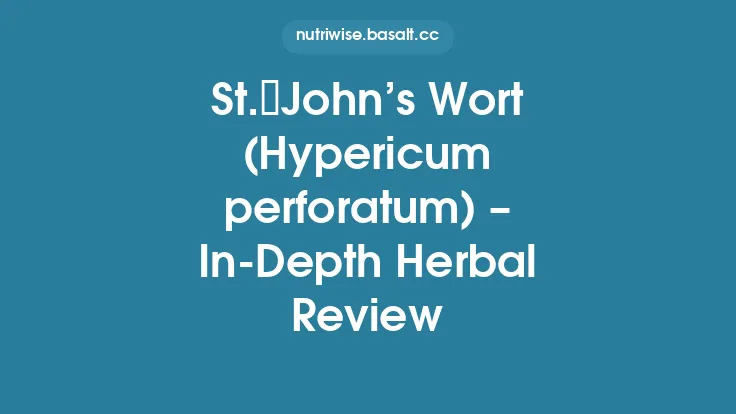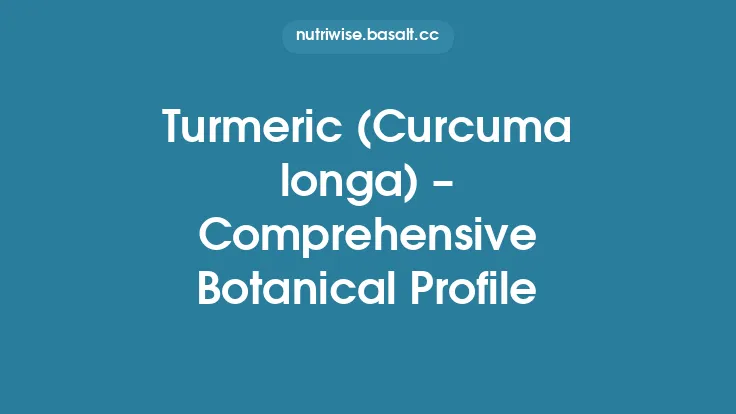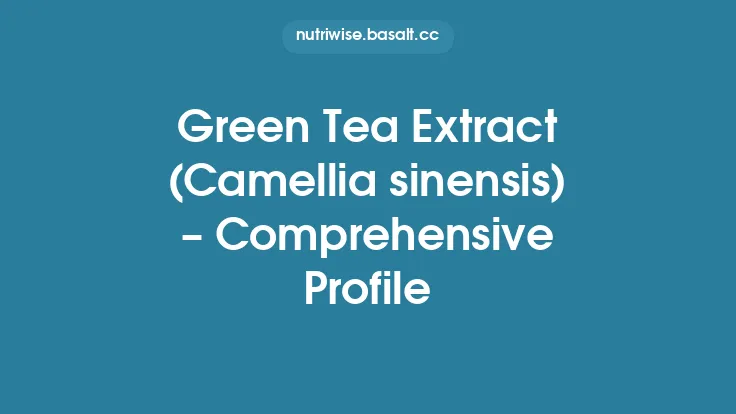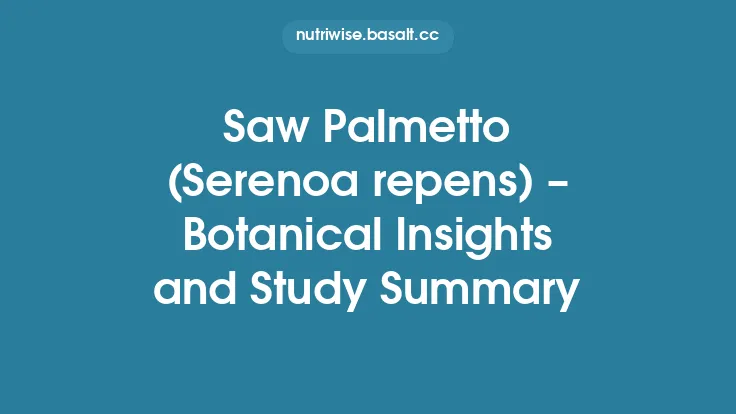Peppermint (Mentha × piperita) is a sterile hybrid between watermint (Mentha aquatica) and spearmint (Mentha spicata) that has been cultivated for centuries for its aromatic leaves, essential oil, and therapeutic properties. Its distinctive cool, menthol‑rich flavor makes it a staple in culinary, cosmetic, and pharmaceutical applications worldwide. Modern research has identified a complex phytochemical profile that underlies peppermint’s diverse pharmacological actions, ranging from smooth‑muscle relaxation to antimicrobial activity. This profile consolidates current botanical, phytochemical, pharmacological, and regulatory knowledge to serve as a comprehensive reference for clinicians, researchers, and supplement formulators.
Botanical Description
Peppermint is a perennial herbaceous plant that typically reaches 30–90 cm in height. Stems are square in cross‑section, a characteristic of the Lamiaceae family, and bear opposite, ovate to lanceolate leaves with a serrated margin. The leaves are dark green on the adaxial surface and paler beneath, exuding a strong menthol aroma when crushed. Inflorescences are terminal spikes composed of small, pink‑purple flowers that bloom in late summer. The plant propagates vegetatively via rhizomes; true seed production is rare due to its hybrid sterility.
Taxonomy and Nomenclature
- Family: Lamiaceae
- Genus: Mentha
- Species: × piperita (hybrid)
- Synonyms: Mentha piperita L., Mentha viridis L.
- Common Names: Peppermint, mentha, peppermint leaf, peppermint oil
The “×” denotes its hybrid origin. While the International Code of Nomenclature permits the use of Mentha piperita as a species name, the hybrid notation more accurately reflects its genetic background.
Phytochemistry
Peppermint’s therapeutic potential is largely attributed to its essential oil, which constitutes 1–3 % of the dried leaf weight. The oil is a complex mixture of terpenoids, phenolic compounds, and flavonoids. Key constituents include:
| Compound | Approx. % (oil) | Pharmacological relevance |
|---|---|---|
| (−)-Menthol | 30–55 % | Analgesic, cooling, smooth‑muscle relaxant |
| Menthone | 10–20 % | Antispasmodic, antimicrobial |
| Menthyl acetate | 3–8 % | Flavor enhancer, mild analgesic |
| 1,8‑Cineole (Eucalyptol) | 2–5 % | Bronchodilator, anti‑inflammatory |
| Limonene | 1–3 % | Antioxidant, anti‑cancer potential |
| Rosmarinic acid (leaf extract) | 0.5–2 % | Antioxidant, anti‑inflammatory |
| Flavonoids (e.g., luteolin, apigenin) | trace | Antioxidant, neuroprotective |
The ratio of menthol to menthone is a critical quality parameter; high‑grade pharmaceutical peppermint oil typically exhibits a menthol:menthone ratio of ≥3:1. Minor constituents such as pulegone, menthofuran, and carvone may be present in trace amounts; excessive pulegone is undesirable due to hepatotoxic potential.
Traditional and Historical Uses
Historical records from ancient Egypt, Greece, and Rome document peppermint’s use as a digestive aid, respiratory decongestant, and topical analgesic. In Ayurvedic medicine, peppermint (Pudina) is classified as a cooling herb (shita) and employed to balance pitta dosha, alleviate dyspepsia, and treat headaches. Traditional Chinese Medicine (TCM) references peppermint as a “cooling” herb used to disperse wind‑heat and relieve throat irritation.
Modern Clinical Evidence
Gastrointestinal Disorders
- Irritable Bowel Syndrome (IBS): Randomized, double‑blind trials have demonstrated that enteric‑coated peppermint oil capsules (180 mg menthol) significantly reduce abdominal pain and global IBS symptoms compared with placebo (effect size d≈0.6). The mechanism is thought to involve calcium‑channel antagonism leading to smooth‑muscle relaxation.
- Functional Dyspepsia: Meta‑analyses of three trials (n≈450) report modest improvements in dyspeptic scores (RR ≈ 1.35) with peppermint oil preparations.
Respiratory Conditions
- Acute Cough and Upper Respiratory Infections: Inhalation of peppermint vapor or menthol lozenges provides a subjective sense of airway cooling and reduces cough frequency, likely mediated by menthol’s activation of TRPM8 receptors in the nasal mucosa.
Analgesia and Musculoskeletal Pain
- Topical formulations containing 5–10 % peppermint oil have shown comparable analgesic efficacy to low‑dose NSAIDs in small crossover studies for tension‑type headaches and minor musculoskeletal discomfort, attributed to counter‑irritant and desensitizing actions on cutaneous nociceptors.
Antimicrobial Activity
- In vitro assays reveal peppermint oil’s broad‑spectrum activity against Gram‑positive bacteria (e.g., Staphylococcus aureus, Streptococcus pneumoniae) and certain fungi (Candida albicans). Minimum inhibitory concentrations (MIC) range from 0.125–0.5 % (v/v), supporting its inclusion in oral hygiene products and preservative systems.
Safety, Contraindications, and Adverse Effects
Peppermint is generally recognized as safe (GRAS) when used in culinary amounts. However, therapeutic doses—particularly concentrated essential oil—require caution:
| Issue | Details |
|---|---|
| Gastroesophageal Reflux Disease (GERD) | Peppermint relaxes the lower esophageal sphincter, potentially exacerbating reflux. |
| Hepatotoxicity | High levels of pulegone (>0.1 % in oil) are hepatotoxic; commercial oils are refined to keep pulegone <0.1 %. |
| Allergic Contact Dermatitis | Rare; patch testing recommended for topical use. |
| Pregnancy & Lactation | Limited data; most guidelines advise avoiding high‑dose oral oil but consider culinary use acceptable. |
| Pediatric Use | Enteric‑coated capsules are not recommended for children <12 years due to risk of esophageal spasm. |
Dosage Forms and Standardization
| Form | Typical Dose | Standardization |
|---|---|---|
| Enteric‑coated capsules | 0.2–0.4 mL (≈180–360 mg menthol) 2–3×/day | Menthol ≥30 % of oil; menthol:menthone ≥3:1 |
| Liquid tincture (alcoholic) | 10–20 drops (≈0.5–1 mL) 3×/day | Oil content 5–10 % v/v |
| Essential oil (topical) | 1–2 % in carrier oil (e.g., almond) | Menthol ≥30 % |
| Tea (dried leaf) | 1–2 g steeped in 250 mL water 3×/day | Not standardized; flavonoid content variable |
| Lozenges / gum | 0.5–1 mg menthol per unit | Menthol content declared on label |
Enteric coating is essential for oral oil capsules to prevent premature release in the stomach, which can cause heartburn and reduce efficacy for intestinal targets.
Drug Interactions
- Cytochrome P450 Enzymes: Menthol modestly inhibits CYP2A6 and CYP3A4 in vitro; clinical relevance is low but caution is advised when co‑administered with drugs having a narrow therapeutic index metabolized by these pathways (e.g., warfarin, certain antiepileptics).
- Anticholinergic Agents: Additive smooth‑muscle relaxation may potentiate gastrointestinal side effects.
- Proton Pump Inhibitors (PPIs) & H2 Blockers: No direct interaction, but the reflux‑exacerbating potential of peppermint may counteract therapeutic goals.
Regulatory Status
- United States: Peppermint oil is listed in the FDA’s GRAS database for food use; as a dietary supplement, it is regulated under the Dietary Supplement Health and Education Act (DSHEA) with no pre‑market approval required. Health claims must be limited to structure‑function statements (e.g., “supports digestive comfort”).
- European Union: Classified as a food flavoring (FL No. 21) and a traditional herbal medicinal product (THMP) under the EU Herbal Directive, permitting limited medicinal claims after a 30‑year traditional use demonstration.
- Canada: Natural Health Product (NHP) monograph permits oral oil capsules up to 0.4 mL per dose for digestive health.
Cultivation, Harvest, and Quality Control
Peppermint thrives in temperate climates with well‑drained, loamy soils and partial shade. Optimal oil yield (1.5–2.5 % of dry weight) is achieved when harvesting just before flowering, when menthol concentration peaks. Post‑harvest, leaves are air‑dried at ≤30 °C to prevent volatilization of menthol. Steam distillation remains the gold standard for oil extraction; supercritical CO₂ extraction is gaining popularity for its lower thermal degradation and higher retention of minor constituents.
Quality control parameters include:
- GC‑MS profiling for menthol, menthone, and pulegone content.
- Optical rotation to confirm the correct enantiomeric composition of menthol (−‑menthol).
- Residual solvent testing for CO₂‑extracted oils.
- Microbial limits per USP <61> and <62>.
Future Directions and Research Gaps
While peppermint’s efficacy for functional gastrointestinal disorders is well‑documented, several areas merit further investigation:
- Long‑term safety of chronic high‑dose menthol supplementation, especially in hepatic function.
- Neurocognitive effects of menthol’s TRPM8 activation on mood and alertness.
- Synergistic formulations combining peppermint oil with other antispasmodics (e.g., fennel, ginger) for IBS sub‑phenotypes.
- Standardized extracts focusing on non‑volatile constituents (rosmarinic acid, flavonoids) to explore antioxidant and anti‑inflammatory pathways beyond menthol.
Summary
Peppermint (Mentha × piperita) stands out among herbal supplements for its well‑characterized essential oil, robust clinical evidence in functional gastrointestinal disorders, and a favorable safety profile when used appropriately. Its pharmacology is driven primarily by menthol’s cooling, analgesic, and smooth‑muscle relaxant actions, complemented by a suite of minor terpenes and phenolics that confer antimicrobial and antioxidant properties. Proper standardization, quality control, and awareness of contraindications—particularly in reflux disease and hepatic vulnerability—are essential for maximizing therapeutic benefit. As research continues to elucidate menthol’s broader physiological impacts, peppermint is poised to retain its status as a versatile, evergreen botanical ingredient in both traditional and modern health‑care contexts.
